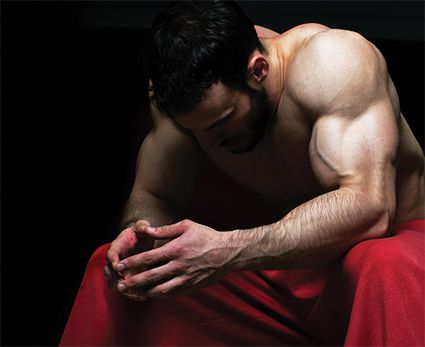How Seasons Affects Your Training

SEASONAL AFFECTIVE DISORDER:
How it Affects Your Training and Your Mood
Seasonal affective disorder (SAD) is a common occurrence in those who live in cold climates during the winter season. Although it’s not completely clear, it’s believed that SAD is most likely the result of a lack of sunlight, which can cause numerous effects on neurotransmitters, hormones, and our sleep-wake cycle, resulting in depressed mood and overall lack of motivation. The good news is that SAD is easily treated with light therapy, supplements, or even a workout. Keep reading to find out all about SAD and what you can do about it.
What Is SAD?
SAD is a mood disorder that occurs at the onset of fall and winter months, usually starting in September or October, when days get shorter and the weather gets colder, and ending in April or May, when days get longer and the weather gets warmer. SAD is characterized by a change in mood from normal mental health during bright spring and summer days, to feelings of depression during darker fall and winter days. Throughout North America, SAD is most prevalent in places such as Alaska, which has an incidence of 9.9 percent; compare that to Florida, which has an incidence of only 1.4 percent. It has also been shown that SAD occurrence increases with latitude, so the further north you go, the more likely you are to experience SAD.

What Causes SAD?
There are a few theories on what causes SAD, including neurotransmitter, hormonal, and circadian rhythm dysregulation, genetic polymorphisms, and psychological factors that are more than likely brought on by the other factors.
Serotonin Dysregulation
One theory is that SAD is caused by a lack of serotonin production, since serotonin production is the lowest in winter months and has been shown to improve when light is increased. When treated with light therapy, patients can subsequently relapse when serotonin and catecholamine levels deplete, indicating therapies that can help stimulate serotonin are effective for light therapy. It’s also thought that serotonin polymorphism may also play a role in SAD, whereby serotonin expression is hindered, resulting in a decrease in serotonin availability.
Phase-Shift Hypothesis
Another hypothesis is the phase shift, where the body’s sleep-wake cycle is disrupted in those with SAD due to the environmental light-dark cycle, resulting in a dysregulation of melatonin release, and therefore a disruption in sleep and cortisol and other hormonal rhythms within a 24-hour period that are necessary for normal sleep-wake cycle and circadian rhythms. It’s theorized that some may be phase-advanced (melatonin release occurs too early in the evening) or phase-delayed (they continue to release melatonin too long in the morning). The theory is that SAD is the result of the seasonal changes in light exposure that disrupt the normal functioning of the circadian clock.

Photon-Count Hypothesis:
The photon-count hypothesis suggests that shorter periods of daylight and less intense light in the winter months result in an insufficient dose of light, and therefore less photon exposure to the retina. The retinas of people with SAD are significantly less sensitive to light than those of control groups. One study showed a positive relationship between depression severity and photoperiod/light intensity. One meta-analysis showed a dose-response relationship between light therapy (intensity) and degree of improvement in typical depressive symptoms.
Melatonin Theory
Another theory of SAD is that it’s caused by a disruption of melatonin release. Our sleep-wake cycle, also known as the circadian rhythm, is controlled by the rise and fall of a sequence of hormones, including melatonin. This hormone is produced by the pineal gland and helps control the sleep-wake cycle. When the sun sets, the photo sensors in our eyes detect darkness, and the body responds by secreting melatonin, thus inducing sleep. Melatonin continues to be released throughout the night until dawn, when melatonin secretion gradually levels off, allowing for wakefulness in the morning. Individuals with SAD appear to have longer duration of melatonin release during winter months than in summer months. It’s hypothesized that people with SAD have increased duration of melatonin secretion in the early morning hours. This would explain why people with SAD have difficulty waking up and don’t feel alert in the morning. Experiments with drugs to block melatonin secretion in the morning, thus decreasing the duration of its secretion, demonstrated that the symptoms of SAD were relieved.
Signs and Symptoms
Because SAD is a depressive disorder, it’s common for suffers to experience the same types of symptoms that would be associated with depression, including general feeling of hopelessness, sadness, loss of interest in activities or social gatherings, disruption of sleep, increase in appetite, low energy levels, decreased sex drive, and general agitation. In addition, those suffering with SAD may experience oversleeping or difficulty waking up due to melatonin dysregulation. If SAD is being caused by serotonin dysregulation, then an increase in appetite may occur, particularly for carbohydrates, which can lead to weight gain.

TREATING SAD:
Light Therapy
The most common therapy for SAD is light therapy, whereby bright light therapy can be used to help reduce the secretion of melatonin when exposed to the light early in the morning, while also helping to regulate the sleep-wake cycle. The recommended dose is 10,000 lux full spectrum light, 2500 lux blue light at a wavelength of 480 nanometres, or 350 lux green light at a wavelength of 500 nanometres with a UV shield for approximately 30 minutes to up to two hours per day depending on the light, for two to four weeks, or until symptoms begin to subside
The best results come when the treatment is tailored to the individual’s sleep-wake cycle and help to correct it. Side effects include headache, eyestrain, and psychomotor agitation. Additionally, those who suffer from retinal diseases or are on medications that increase sensitivity to light should not use light therapy. Meta-analysis on studies using light therapy for SAD treatment have found that 53 percent of individuals with SAD experienced full remission; however, only 43 percent of individuals with moderate to severe SAD had remission of symptoms with light therapy. In addition to the lack of complete effectiveness, most find light box therapy to be inconvenient, causing inconsistent treatment. In addition to simple light box therapy, there is also “dawn simulation,” whereby lights are used to spark a more natural sleep-wake cycle. This is particularly helpful for those suffering with phase-delay. Lastly, light therapy can be as simple as getting outside and getting exposure to sunlight, although this might not always be that easy during the long, cold Canadian winter.
Workouts
This may not be a surprise, but perhaps one of the easiest and cheapest ways to cure SAD is via your workout. You probably already know that working out stimulates feel-good endorphins that have been shown to help treat depression. In one study, the effect of 20 minutes of light therapy was compared to exercise therapy in the form of cycling on a stationary bike for 20 minutes per day. Both exercise and light therapy had similar and significant reductions in depression severity. It should be noted that light therapy in the morning may be most beneficial for helping to correct the sleep-wake cycle, whereas exercise in the evening may further delay sleep due to the release of stimulating endorphins, including norepinephrine, which slows down the release of melatonin.
In another study, exercise performed under light therapy of 2500 to 4000 lux was found to be more effective than exercise performed under normal gym lighting; thus, outdoor exercise or combining exercise with light therapy is most effective for SAD.

SUPPS FOR SAD:
Vitamin D
Low levels of vitamin D have been associated with the onset of SAD. When given a large dose of vitamin D of 100,000 IU in conjunction with light therapy for one month, subjects receiving the vitamin D improved symptoms, while the light therapy-only group showed no significant changes in depression scale measure. Additionally vitamin D status was improved in not just the individuals receiving vitamin D but also those receiving light therapy.
5-HTP
5-HTP is the precursor for the neurotransmitter 5-HTP. In the body, 5-HTP is converted to serotonin, helping increase the level of serotonin in the body. An effective dose for 5-HTP is 200 to 500 milligrams, which has been shown to help improve sleep quality and reduce depression symptoms. However, it should be noted that one study showed that increasing serotonin levels also resulted in an increase in cortisol levels.
Vitamin B6
The conversion of tryptophan to 5-HTP is dependent on the availability of vitamin B6, as well as magnesium. Vitamin B6 is a necessary co-factor involved in the production of serotonin. Getting your daily intake of 1.3 milligrams of vitamin B6 should be considered as part of SAD treatment.
Magnesium
Research suggests that deficiency of magnesium can inhibit the conversion of tryptophan to 5-HTP, which can affect the production of serotonin and melatonin. Research has also suggested that magnesium deficiency can result in dysregulation of the biological clock, and the sleep-wake cycle due to deficiency in melatonin and or serotonin. One study showed that rapid recovery (less than seven days) from major depression using 125 to 300 milligrams of magnesium (as glycinate and taurinate) with each meal and at bedtime. The daily recommended dose of magnesium is 400 milligrams per day.
St. John’s Wort
It has been shown that St John’s wort is an effective treatment to help with depression, but also the symptoms of SAD. In one study, it was shown that a 900-milligram dose of an extract of St. John’s wort was as effective as light therapy in those suffering with SAD. Another study found that the same dose in combination with 3,000 lux bright light therapy or 300 lux dim light therapy reduced depressive symptoms in patients with SAD.
(Editor’s Note: To read more on how to maximize your health, check out this article by Canada’s premier fitness expert John Cardillo.)

